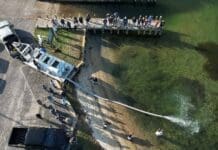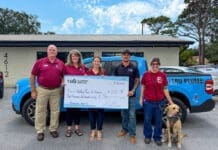By Alison “Ali” Jean, CBA Education Technician
My title may be an Education Technician, but I am a multi-faceted employee at Choctawhatchee Basin Alliance (CBA). Of the many roles I play within our organization, my favorite is the manager of our Choctawhatchee Oyster Gardening Program where volunteer oyster gardeners raise oysters at their dock for our living shoreline initiative.
You may have read the article previously written by my colleague, Chad Perko, about our oyster shell recycling program. Building a recycled-shell reef reduces shoreline erosion, provides habitat for over 300 species of marine organisms, and keeps spent shells from restaurants out of landfills. “The oyster gardening program helps jump-start oyster growth on a newly constructed reef by placing adult oysters at the site to seed the reefs,” says Restoration Coordinator, Rachel Gwin. Some of the shells are set aside to use in our oyster gardens where they become the foundation for new oyster growth.
Oyster gardening spans eleven months, beginning when water temperatures reach 68°F to April of the following year. With billions of larvae floating in the water column, only a fraction survive and attach to a hard surface. “Providing more spaces for oyster spat to settle enables more oysters to thrive in places where they may not have been otherwise able to,” states Monitoring Coordinator, Jenna Kilpatrick. Once oysters reach maturity, each garden of oysters raised in our program has the potential to filter up to 12,000 gallons of water per day after planting. Imagine if all dock owners in Choctawhatchee Bay cared for at least one oyster garden on their property.
As a keystone species, the addition of oysters creates a foundation for new habitats throughout the bay. As oysters accumulate on the shells, they become the reef — something like living infrastructure, providing shelter for invertebrates and fish within nooks and crannies. Some organisms feed on oysters directly, while larger marine critters will use reefs as hunting grounds. Even the waste from oysters is an important form of food for detritivores.
Oyster gardening allows community members to volunteer small increments of their time over a long period without leaving their homes. Volunteers can log upwards of 40 volunteer hours by tending their gardens one hour a week. Our volunteers can spend family time exploring the plethora of critters that flock to your garden.
“Oyster gardening adds another outreach component to connect people to the local environment through hands-on activities,” says Alison McDowell. Oyster gardeners play an important role in restoring oyster habitat. If oyster gardening seems to float your boat, the program application and the online workshop are on our website under the volunteer tab. To find out more information, please visit CBA’s oyster gardening page or contact Ali Jean at jeana1@nwfsc.edu.





























































